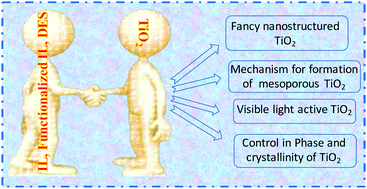Current status and future challenges in ionic liquids, functionalized ionic liquids and deep eutectic solvent-mediated synthesis of nanostructured TiO2: a review
Abstract
Titanium dioxide-nanostructured materials have been intensively pursued for modern science and nanotechnology. Recently, significant advances have been made with respect to the synthetic methodology of titania using all the generations of ionic liquids (ILs) as solvents, reactants and templates, resulting in controllable morphologies and physicochemical properties. This review presents an in-depth discussion on the development of ILs as a template-based synthetic strategy for TiO2 fancy nanostructures. The other sections of this review comprises the mechanisms involved in the synthesis of mesoporous structures, influence of ILs on the phase and crystallinity of titania, ILs serving as microwave absorbers, and contribution of ILs in the synthesis of visible light responsive titania, where a single dopant source can dope the substrate with different elements based on the synthetic recipe. Finally, we concluded with very recent research on the synthesis of titania using the third-generation of ILs, known as deep eutectic solvents. Personal perspectives have been provided on future research efforts for addressing the remaining challenges in the design of TiO2.

- This article is part of the themed collection: 2017 Focus and Perspective articles


 Please wait while we load your content...
Please wait while we load your content...